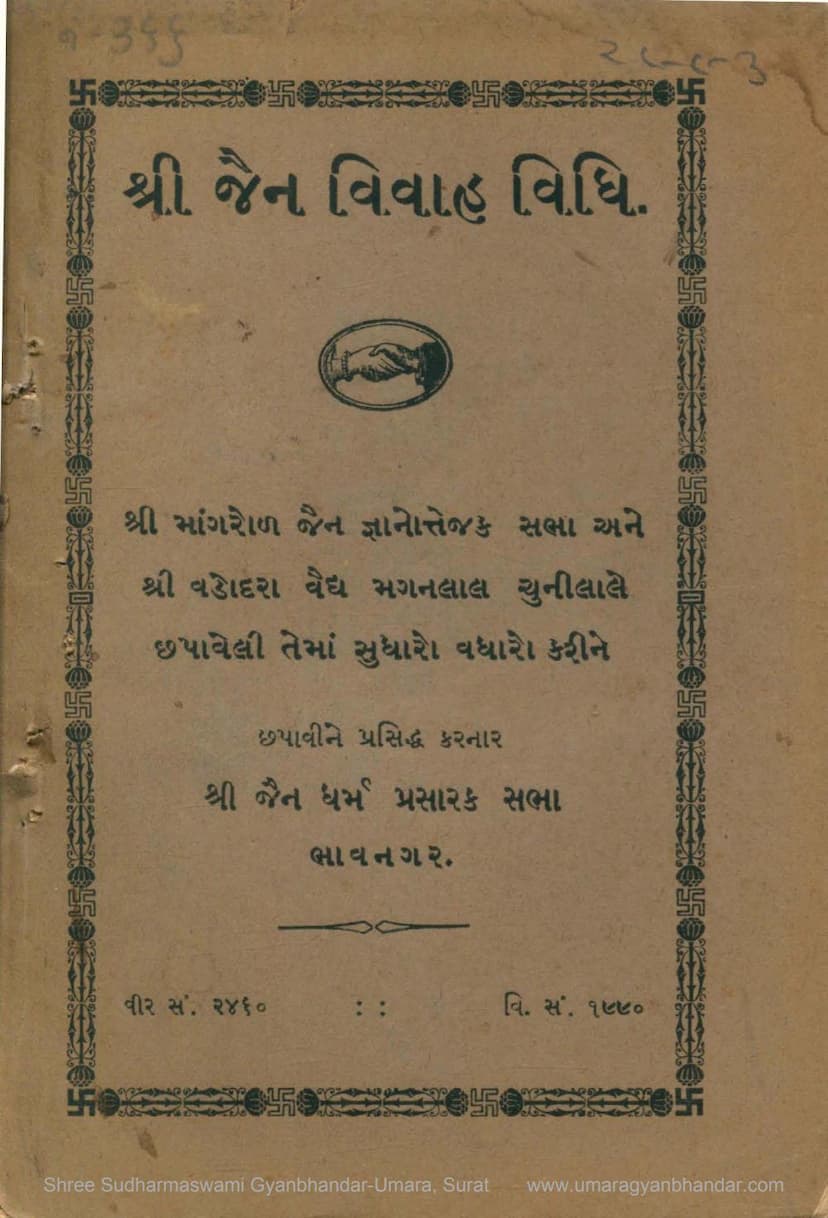Jain Vivah Vidhi
Added to library: September 2, 2025
Loading image...

Summary
This document, "Shree Jain Vivah Vidhi" (Jain Marriage Rituals), published by Shree Jain Dharm Prasarak Sabha, Bhavnagar, is a comprehensive guide to conducting Jain weddings. It aims to provide a pure and traditional Jain wedding ceremony, free from extraneous rituals associated with other religions.
Key Features and Content:
- Revival of Traditional Rituals: The text emphasizes the importance of adhering to Jain principles and rituals, directly referencing the practices followed by Lord Rishabhdev. It explicitly discourages the worship of Ganesh or other deities and the reverence of fire as a divine entity, which are considered to promote "mithyatva" (false beliefs) and weaken "samakit" (right faith).
- Influence of "Achar Dinakar": The ritualistic procedures are based on the extensive work "Achar Dinakar" by Shriman Vardhamansuri, highlighting sixteen essential sacraments for a Shravak (lay Jain follower), with marriage being a particularly crucial one.
- Inclusion of Mantras with Meanings: Sanskrit mantras are provided for various stages of the wedding, along with their Gujarati explanations, to ensure the participants understand the underlying meaning and significance of each ritual.
- Emphasis on Jain Priests/Gurus: The publication encourages the community to train individuals within their own community (Jain school teachers or learned individuals) to conduct the ceremonies. It advises against disrespecting or disrupting the livelihood of traditional family priests (kulgor) but rather to seek their cooperation, possibly by designating them as "Grihastha Guru" (householder gurus) who are virtuous and not antagonistic to Jainism.
- Practical Guidance: The book details the necessary materials (samagri) for each ritual, offering flexibility if certain items are unavailable.
- Specific Sections Highlighted:
- Page 2: Shiyal Vishay Shikhaman (Advice on Chastity): This section contains a devotional song advising women on maintaining chastity, respect for elders, and devotion to God.
- Page 4: Special Notice to Jain Brethren: This page reiterates the directive to avoid non-Jain rituals and follow the prescribed Jain vidhi to strengthen faith.
- Page 5-6: Preface (Prastavana): This section elaborates on the book's purpose, its reliance on ancient Jain texts, and the need for community participation in promoting these rituals.
- Page 7: Table of Contents (Anukramanika): This provides a detailed breakdown of the various rituals and their corresponding page numbers, covering everything from initial arrangements to post-wedding ceremonies.
- Page 8-10: Dhal Navmi & Dhal Agyarmi (Songs from the Marriage of Parshvanath): These are devotional songs describing wedding processions and specific ritualistic interpretations of wedding customs, highlighting symbolic actions.
- Page 11 onwards: Detailed Rituals: The subsequent pages detail specific ceremonies like:
- Vivah Sambandh (Engagement): Procedures and mantras for confirming the marriage alliance.
- Lagan Niradhar (Marriage Determination): Astrology and fixing the auspicious date.
- Matruka Sthapan (Establishment of Matrikas/Mother Goddesses): Detailed instructions for invoking and worshipping eight mother goddesses, with specific mantras for each.
- Sapt Kulkar ni Sthapana (Establishment of Seven Kulakars): Instructions for worshipping the seven ancestral patriarchs of humanity according to Jain tradition.
- Mandap Sthapana & Grahashanti (Mandap Installation & Graha Shanti): Rituals for setting up the wedding canopy and appeasing planetary influences.
- Lagne Varghodo (Wedding Procession): Description of the groom's procession with accompanying mantras for auspiciousness.
- Mayara no Prakar (Mayara Ritual): Details of the rituals performed in the groom's family area.
- Mangalashtak: Auspicious verses recited during the wedding.
- Hastabandhan (Hand Tying) & Vidi Pratishtha (Altar Consecration): Rituals involving tying the couple's hands together and consecrating the wedding altar.
- Agnisthapan & Havan (Fire Ritual): Procedures for establishing the sacred fire and performing oblations with specific mantras.
- Abhishek (Anointment) & Gotrochhar (Lineage Pronouncement): Rituals involving ceremonial bathing and declaring the lineages of the bride and groom.
- Pradakshina/Pheras (Circumambulations): The sacred circumambulations around the fire with specific mantras for each round.
- Kanyagrahan Sankalp (Bride Acceptance Vow): Formal acceptance of the bride by the groom.
- Vaskshep Vidhi (Confetti Ritual): A ritual of showering blessed rice or flowers.
- Karamochhan (Hand Separation): The ritual of separating the hands after the sacred tying.
- Grahstay Guru na Ashirwad (Blessings from the Householder Guru): Bestowing blessings by the officiant.
- Visarjan (Immersion/Farewell): Rituals for bidding farewell to the Matrikas and Kulakars.
- Page 66-68: Material Lists and Kanya Shikhaman (Bride's Advice): This section lists the materials needed for various rituals and includes a devotional song from the marriage of Parshvanath, offering advice to the bride, and the bride's respectful reply to her mother.
In essence, "Shree Jain Vivah Vidhi" serves as a detailed manual to ensure that Jain weddings are conducted according to their religious tenets, promoting spiritual purity and family harmony.